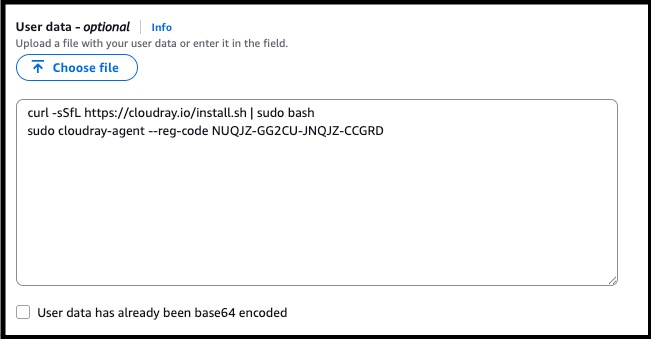CloudRay Agent on AWS
You can install the CloudRay Agent on Amazon EC2, using two methods:
- Option 1: Installing on new instances using EC2 User Data
- Option 2: Installing manually on existing EC2 instances
The CloudRay Agent securely connects your EC2 instance to the CloudRay dashboard without SSH, allowing you to monitor and manage it in real-time.
TIP
Before you begin, ensure you have a CloudRay account and obtain your REG_CODE from the project dashboard.
Option 1: New EC2 Instances (via User Data)
You can use EC2 User Data to automatically install and register the CloudRay Agent when launching a new instance.
- Launch a new EC2 instance from the AWS Console
- Under Advanced Details, locate the User Data section

- Paste the following script (replace
<REG_CODE>):
#!/bin/bash
curl -sSfL https://cloudray.io/install.sh | sudo bash
sudo cloudray-agent install-service --reg-code <REG_CODE>The install.sh script is safe to run multiple times; it will automatically update the Agent if a newer version is available or leave it untouched if it’s already up to date.
- Complete the rest of the EC2 launch steps and start the instance
Option 2: Existing EC2 Instances
Install the CloudRay Agent manually on a running EC2 instance via SSH or Session Manager. For detailed connection instructions, refer to the official AWS EC2 connection documentation.
- Connect to your EC2 instance using EC2 Instance Connect or SSH.
- Run the following commands:
curl -sSfL https://cloudray.io/install.sh | sudo bash
sudo cloudray-agent install-service --reg-code <REG_CODE>- Verify that the instance appears in your CloudRay dashboard under Machines
Alternative: Connect via SSH
If you can’t install the CloudRay Agent, you can still manage your machines using SSH. See SSH-Based Servers to get started with traditional SSH connections.